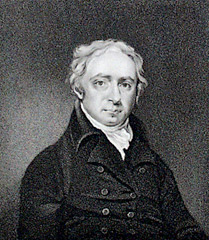William Lisle Bowles facts for kids
Quick facts for kids
William Lisle Bowles
|
|
|---|---|
 |
|
| Born | 24 September 1762 King's Sutton, Northamptonshire, England
|
| Died | 7 April 1850 (aged 87) |
| Occupation | Clergyman, poet, critic |
William Lisle Bowles (born September 24, 1762, died April 7, 1850) was an English priest, a writer of poems, and a literary critic. He was known for his gentle poetry and his ideas about what makes good poetry.
Contents
Early Life and Education
William Lisle Bowles was born in King's Sutton, Northamptonshire, England. His father was a vicar, which is a type of priest in the Church of England.
When he was 14, Bowles went to Winchester College, a famous school. The headmaster there was Dr. Joseph Warton. In 1781, Bowles finished school as the "captain," meaning he was a top student.
After Winchester, he earned a scholarship to Trinity College, Oxford. This is a well-known university. Two years later, he won an award for his Latin poetry.
Becoming a Priest and Poet
William Lisle Bowles came from a family of priests. His great-grandfather, grandfather, and father were all priests in the Church of England.
After finishing his studies at Oxford, Bowles also became a priest. In 1792, he became the vicar of Chicklade in Wiltshire. A vicar is a priest in charge of a local church.
Later, he became the vicar of Bremhill in Wiltshire in 1804. He wrote a poem there that is now on a statue of a local person named Maud Heath.
Bowles also held other important roles in the church. He was a special priest called a "prebendary" at Salisbury Cathedral. In 1818, he became a chaplain to the Prince Regent, who later became King George IV.
His Famous Poems
In 1789, Bowles published a small book called Fourteen Sonnets. These poems were very popular. Famous poets like Samuel Taylor Coleridge and William Wordsworth admired them.
Coleridge even said that Bowles, along with another poet named Charlotte Smith, helped bring back the sonnet. A sonnet is a poem with 14 lines.
Bowles's sonnets were different from other poems at the time. They were known for their beautiful words, musical rhythm, and gentle feelings. They also showed a deep love for nature.
Bowles himself said his poems were "poetic trifles from solitary rambles." This means he wrote them during quiet walks, thinking about sweet and bitter memories. He felt the 14-line sonnet was best for expressing one main feeling.
Ideas About Poetry
Bowles wrote some longer poems, but they are not as famous as his sonnets. Some of these include The Spirit of Discovery (1804) and The Missionary (1813).
He was also a well-known critic, meaning he wrote about and judged other people's writing. In 1806, he published an edition of Alexander Pope's works. In this book, he shared his ideas about what makes good poetry.
Bowles believed that images from nature were more poetic than images from art or city life. He also thought that the best poems should focus on big, general feelings and ideas, not just the everyday customs of society.
These ideas caused a big debate among writers. Poets like Lord Byron and Thomas Campbell disagreed with him. However, other critics like William Hazlitt supported Bowles.
In the end, many of Bowles's ideas about poetry became widely accepted. He helped start a new way of thinking about English poetry.
Other Works and Legacy
William Lisle Bowles was known for being a kind, a bit forgetful, and sometimes unusual person. His poems are full of gentle feelings and thoughtful ideas.
Besides poetry, he also wrote a two-volume book about the life of Bishop Ken (1830–1831). Other works include Coombe Ellen and St. Michael's Mount (1798) and The Battle of the Nile (1799).
Bowles was also interested in old things and history, known as an "antiquary." His main work in this area was Hermes Britannicus (1828). His collected poems were published in 1855.
See also
 In Spanish: William Lisle Bowles para niños
In Spanish: William Lisle Bowles para niños

